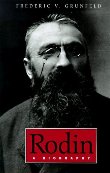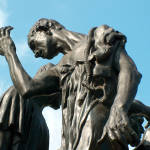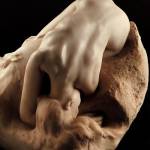Following up on a series of posts about Michelangelo, Beethoven, and Liszt.
 From Frederic V. Grunfeld’s very good Rodin: A Biography, the answer in the case of August Rodin is education and self education.
From Frederic V. Grunfeld’s very good Rodin: A Biography, the answer in the case of August Rodin is education and self education.
Rodin was born into a French culture in which the large majority of the population was illiterate or semi-literate. The fact that Rodin’s father was a member of the literate civil service was an important first step.
Rodin’s uncle owned an operated a private boys’ school in Beauvais, and, Grunfeld reports, “August spent four years at the Pension Rodin and became an outstanding student in several subjects” (p. 14).
After that, the young August had much free time, and, in August’s own words he spent much of it at the “library near the Panthéon [the Bibliothéque Sainte-Geneviéve]. One day I found a big book on the table. It was a book of engraved prints after the works of Michelangelo. They were like a revelation to me. The next day I asked for the book again. And soon I was overcome by a desire to model works like those I saw. I had found my calling!” (p. 16)
after the works of Michelangelo. They were like a revelation to me. The next day I asked for the book again. And soon I was overcome by a desire to model works like those I saw. I had found my calling!” (p. 16)
His self-education continued intensively. Grunfeld: “Rodin’s passion for sculpture did not diminish his curiosity about other areas of art, particularly those which were not covered by the curriculum of the Petite Ecole. His genius for assembling bits and pieces, which was to become another of his hallmarks as a sculptor, also served him well in his search for a more comprehensive education. Mid-century Paris offered several free courses in art, and there were a number of institutions that enable penniless students to improve their minds at public expense. Rodin took whatever suited his needs and worked out a program that included part-time courses in literature and history at the Collége de France, visits to galleries and libraries,  anatomy lectures at the Dupuytren medical museum, some private lessons, ‘night school’ at the Gobelins tapestry factory and, finally, years of practical experience as an assistant in other sculptors’ studios” (pp. 21-22).
anatomy lectures at the Dupuytren medical museum, some private lessons, ‘night school’ at the Gobelins tapestry factory and, finally, years of practical experience as an assistant in other sculptors’ studios” (pp. 21-22).
So: For Rodin, greatness came from hard work fueled by strong passion and deep knowledge.
[The first sculpture image is of one of the figures in Rodin’s The Burghers of Calais (1880s), located outside Westminster in England; the full work can be seen here. The second image is Rodin’s Danaid (1886), at the Musée Rodin in Paris.]
[Related: How great artists become great, and More on how great artists become great.]